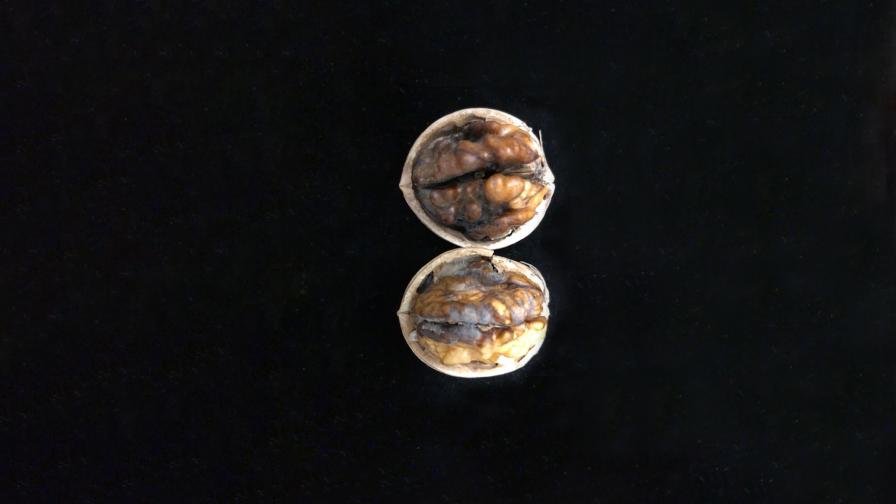New Pathogens are the Culprit for More California Walnut Mold

Walnut mold levels have increased to as much as 20% in some varieties, resulting in economic losses for growers.
Photo by Themis J. Michailides
When more walnuts were downgraded due to a moldy and off-color appearance in recent years, California growers and pest control advisers were left puzzled. As rates of walnut mold in ‘Chandler’ varieties reached 21% in Tulare County, Themis Michailides, Plant Pathologist at University of California, Davis, knew the economic losses posed a serious problem for growers.
“I’ve been with the university for more than 30 years, studying walnuts for 10, and mold, specifically, for the last three,” he says. “With the increased reports of growers getting dinged for mold and decay, I knew we had to address the issue.”
This prompted Michailides to gain funding from the California Walnut Board and various chemical companies to investigate the unusually high levels of walnut mold.
FOCUS ON FUNGI
Between 2019 and 2020, Michailides and his team studied walnut mold to discover when and how it develops and determine best management practices.
He and his team collected samples and isolated various types of fungi from both nuts, hulls, and Brown Apical Necrosis (BAN) tissues. BAN is usually initiated at the stylar end by the walnut blight bacterial pathogen Xanthomonas arboricola pv. Juglandis. Unlike walnut blight, internal tissues in nuts with BAN do not show any decay or black liquification of the kernel.
Results showed consistent evidence of fungi including Alternaria, Fusarium, Aspergillus niger, Botryosphaeria, and Phomopsis. Botryosphaeria and Phomopsis are also known to cause low levels of walnut mold. While Alternaria, Fusarium, and Aspergillus niger were not considered walnut pathogens, lab and field tests confirmed that these fungi were mainly responsible for the higher rates of walnut mold.
Aspergillus niger and Neoscytalidium dimitiatum (the latter pathogen causing branch wilt in walnuts) were also particularly severe. Additionally, walnut blight may exacerbate the problem, leading to larger lesions on the hull and the potential for greater damage to the hull and nut.
“While we thought the mold may begin in the stem, under the microscope, we confirmed a strong correlation of fungi causing kernel mold and also attacking and decaying the hulls,” Michailides says. “We also found through inoculation work that most pathogens that caused walnut mold become apparent later in the season.”
MANAGING MOLD
While it is unclear what caused the high level of mold lately — perhaps smoke from wildfires increasing humidity in the orchards, or drought and high temperatures that foster fungi that thrive on dry heat (i.e., Aspergillus or neoscytalidium) — there is hope for growers to turn things around and mitigate the problem.
Previous studies have shown that Botryosphaeria and Phomopsis can be managed by pruning dead or diseased wood/spurs, as well as pruning after harvest in the fall to reduce spore inoculum and improve ventilation. Employing proper irrigation techniques, such as reducing sprinkler angles to avoid wetting tree limbs, is also helpful in avoiding a humid environment that encourages mold formation. Orientation can also play a role. For example, pistachios fare better facing north to south due to northwest winds. Michailides says that such practices can also be effective in minimizing walnut mold caused by other fungi too by increasing orchard ventilation and reducing humidity.
“Failing to keep up with proper cultural practices and delaying harvest can result in an overcrowded canopy that enhances a greenhouse effect, building high humidity in orchards, which increases the chance of mold,” Michailides says.
While Michailides has not seen much success with biologics, he and his team set trials to study fungicide treatment. They applied a mixture of Merivon spray with tebuconazole a few weeks before hull split, and then a spray of Rhyme fungicide (which has a shorter pre-harvest interval) at 20% to 30% hull split. This reduced incidents of walnut mold by 30% to 70% in both early and late walnut cultivars for two years. However, he reminds growers to refer to current label recommendations and PHI restrictions when applying pesticides.
Also, while the team was under the impression that mold invades through the stem, they found that the incidence of mold starting from the stylar on the other end was significantly greater, suggesting that infection may begin early in the growing season. The team is currently evaluating data from its 2021 trial, which included applying bloom sprays in April. They are excited to evaluate the results.










